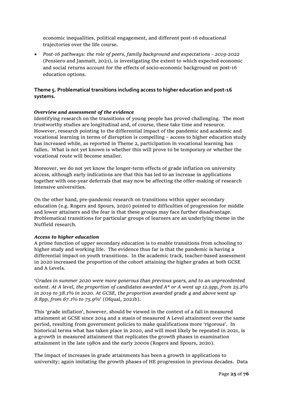
Page 25 of 76
economic inequalities, political engagement, and different post-16 educational
trajectories over the life course.
• Post-16 pathways: the role of peers, family background and expectations - 2019-2022
(Pensiero and Janmatt, 2021), is investigating the extent to which expected economic
and social returns account for the effects of socio-economic background on post-16
education options.
Theme 5. Problematical transitions including access to higher education and post-16
systems.
Overview and assessment of the evidence
Identifying research on the transitions of young people has proved challenging. The most
trustworthy studies are longitudinal and, of course, these take time and resource.
However, research pointing to the differential impact of the pandemic and academic and
vocational learning in terms of disruption is compelling - access to higher education study
has increased while, as reported in Theme 2, participation in vocational learning has
fallen. What is not yet known is whether this will prove to be temporary or whether the
vocational route will become smaller.
Moreover, we do not yet know the longer-term effects of grade inflation on university
access, although early indications are that this has led to an increase in applications
together with one-year deferrals that may now be affecting the offer-making of research
intensive universities.
On the other hand, pre-pandemic research on transitions within upper secondary
education (e.g. Rogers and Spours, 2020) pointed to difficulties of progression for middle
and lower attainers and the fear is that these groups may face further disadvantage.
Problematical transitions for particular groups of learners are an underlying theme in the
Nuffield research.
Access to higher education
A prime function of upper secondary education is to enable transitions from schooling to
higher study and working life. The evidence thus far is that the pandemic is having a
differential impact on youth transitions. In the academic track, teacher-based assessment
in 2020 increased the proportion of the cohort attaining the higher grades at both GCSE
and A Levels.
'Grades in summer 2020 were more generous than previous years, and to an unprecedented
extent. At A level, the proportion of candidates awarded A* or A went up 12.9pp, from 25.2%
in 2019 to 38.1% in 2020. At GCSE, the proportion awarded grade 4 and above went up
8.8pp, from 67.1% to 75.9%' (Ofqual, 2021b).
This 'grade inflation', however, should be viewed in the context of a fall in measured
attainment at GCSE since 2014 and a stasis of measured A Level attainment over the same
period, resulting from government policies to make qualifications more 'rigorous'. In
historical terms what has taken place in 2020, and will most likely be repeated in 2021, is
a growth in measured attainment that replicates the growth phases in examination
attainment in the late 1980s and the early 2000s (Rogers and Spours, 2020).
The impact of increases in grade attainments has been a growth in applications to
university; again imitating the growth phases of HE progression in previous decades. Data